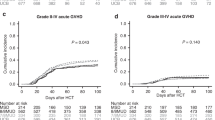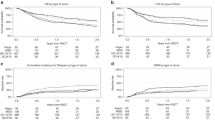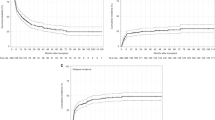Abstract
We investigated whether a young human leukocyte antigen (HLA)-matched unrelated donor (MUD) should be preferred as donor to an HLA-identical sibling (MRD) for older patients with myelodysplastic syndrome (MDS) (⩾50 years) who underwent allogeneic stem cell transplantation (AHSCT). Outcomes of 719 MDS patients with a median age of 58 years (range, 50–73 years) who received AHSCT from related (n=555) or unrelated (n=164) donors between 1999 and 2008 and reported to the European Group for Blood and Marrow Transplantation were analyzed. The median donor age of the MRD was 56 years (range: 35–78), in contrast to 34 years (range: 19–64) for the MUDs. Influence of donor’s age on survival was not observed for MRD (hazard ratio (HR): 1.01 (95% confidence interval (CI): 0.99–1.02), P=0.2), but there was a significant impact of MUD’s age on outcome (HR: 1.03 (95% CI: 1.01–1.06); P=0.02). Transplantation from younger MUDs (<30 years) had a significant improved 5-year overall survival in comparison with MRD and older MUDs (>30 years): 40% vs 33% vs 24% (P=0.04). In a multivariate analysis, AHSCT from young MUD (<30 years) remained a significant factor for improved survival in comparison with MRD (HR: 0.65 (95% CI: 0.45–0.95), P=0.03), which should be considered in donor selection for older patients.
This is a preview of subscription content, access via your institution
Access options
Subscribe to this journal
Receive 12 print issues and online access
$259.00 per year
only $21.58 per issue
Buy this article
- Purchase on Springer Link
- Instant access to full article PDF
Prices may be subject to local taxes which are calculated during checkout


Similar content being viewed by others
References
Anderson JE, Anasetti C, Appelbaum FR, Schoch G, Gooley TA, Hansen JA et al. Unrelated donor marrow transplantation for myelodysplasia (MDS) and MDS-related acute myeloid leukaemia. Br J Haematol 1996; 93: 59–67.
Castro-Malaspina H, Harris RE, Gajewski J, Ramsay N, Collins R, Dharan B et al. Unrelated donor marrow transplantation for myelodysplastic syndromes: outcome analysis in 510 transplants facilitated by the National Marrow Donor Program. Blood 2002; 99: 1943–1951.
Cutler CS, Lee SJ, Greenberg P, Deeg HJ, Pérez WS, Anasetti C et al. A decision analysis of allogeneic bone marrow transplantation for the myelodysplastic syndromes: delayed transplantation for low-risk myelodysplasia is associated with improved outcome. Blood 2004; 104: 579–585.
de Witte T, Hermans J, Vossen J, Bacigalupo A, Meloni G, Jacobsen N et al. Haematopoietic stem cell transplantation for patients with myelo-dysplastic syndromes and secondary acute myeloid leukaemias: a report on behalf of the Chronic Leukaemia Working Party of the European Group for Blood and Marrow Transplantation (EBMT). Br J Haematol 2000; 110: 620–630.
Martino R, Iacobelli S, Brand R, Jansen T, van Biezen A, Finke J et al. for the Myelodysplastic Syndrome subcommittee of the Chronic Leukemia Working Party of the European Blood and Marrow Transplantation Group. Retrospective comparison of reduced-intensity conditioning and conventional high-dose conditioning for allogeneic hematopoietic stem cell transplantation using HLA-identical sibling donors in myelodysplastic syndromes. Blood 2006; 108: 836–846.
Lim Z, Brand R, Martino R, van Biezen A, Finke J, Bacigalupo A et al. Allogeneic hematopoietic stem-cell transplantation for patients 50 years or older with myelodysplastic syndromes or secondary acute myeloid leukemia. J Clin Oncol 2010; 28: 405–411.
Ho AY, Pagliuca A, Kenyon M, Parker JE, Mijovic A, Devereux S et al. Reduced-intensity allogeneic hematopoietic stem cell transplantation for myelodysplastic syndrome and acute myeloid leukemia with multilineage dysplasia using fludarabine, busulphan, and alemtuzumab (FBC) conditioning. Blood 2004; 104: 1616–1623.
Kollman C, Howe CW, Anasetti C, Antin JH, Davies SM, Filipovich AH et al. Donor characteristics as risk factors in recipients after transplantation of bone marrow from unrelated donors: the effect of donor age. Blood 2001; 98: 2043–2051.
Carreras E, Jiménez M, Gómez-García V, de la Cámara R, Martín C, Martínez F et al. Donor age and degree of HLA matching have a major impact on the outcome of unrelated donor haematopoietic cell transplantation for chronic myeloid leukaemia. Bone Marrow Transplant 2006; 37: 33–40.
Ash RC, Horowitz MM, Gale RP, van Bekkum DW, Casper JT, Gordon-Smith EC et al. Bone marrow transplantation from related donors other than HLA-identical siblings: effect of T cell depletion. Bone Marrow Transplant 1991; 7: 443–452.
Kröger N . Allogeneic stem cell transplantation for elderly patients with myelodysplastic syndrome. Blood 2012; 119: 5632–5639.
Guardiola P, Runde V, Bacigalupo A, Ruutu T, Locatelli F, Boogaerts MA et al. Retrospective comparison of bone marrow and granulocyte colony-stimulating factor-mobilized peripheral blood progenitor cells for allogeneic stem cell transplantation using HLA identical sibling donors in myelodysplastic syndromes. Blood 2002; 99: 4370–4378.
Miller RA . The aging immune system: primer and prospectus. Science 1996; 273: 70–74.
Davies SM, Kollman C, Anasetti C, Antin JH, Gajewski J, Casper JT et al. Engraftment and survival after unrelated-donor bone marrow transplantation: a report from the national marrow donor program. Blood 2000; 96: 4096–4102.
Schultz KR, Green GJ, Wensley D, Sargent MA, Magee JF, Spinelli JJ et al. Obstructive lung disease in children after allogeneic bone marrow transplantation. Blood 1994; 84: 3212–3220.
Author information
Authors and Affiliations
Consortia
Corresponding author
Ethics declarations
Competing interests
The authors declare no conflict of interest.
Additional information
Author contributions
NK designed the study, analyzed, interpreted data and wrote the manuscript. TZ, LdW and JB performed statistical analysis, HA and AvB collected patients data. NM, LV, MM, VL, DB, JF, NS, MR contributed patients data. TdW wrote the manuscript. All authors approved the final version of the manuscript.
Rights and permissions
About this article
Cite this article
Kröger, N., Zabelina, T., de Wreede, L. et al. Allogeneic stem cell transplantation for older advanced MDS patients: improved survival with young unrelated donor in comparison with HLA-identical siblings. Leukemia 27, 604–609 (2013). https://doi.org/10.1038/leu.2012.210
Received:
Revised:
Accepted:
Published:
Issue Date:
DOI: https://doi.org/10.1038/leu.2012.210
Keywords
This article is cited by
-
Impact of donor age and relationship on outcomes of peripheral blood haploidentical hematopoietic cell transplantation
Bone Marrow Transplantation (2023)
-
Should a matched sibling donor still be considered the primary option for allogeneic hematopoietic cell transplantation in patients over 50 years of age with myelodysplastic syndrome?
Bone Marrow Transplantation (2023)
-
Comparison of outcomes for HLA-matched sibling and haplo-identical donors in Myelodysplastic syndromes: report from the chronic malignancies working party of EBMT
Blood Cancer Journal (2022)
-
Risk factors for outcome after allogeneic stem cell transplantation in patients with advanced phase CML
Bone Marrow Transplantation (2021)
-
Impact of the combination of donor age and HLA disparity on the outcomes of unrelated bone marrow transplantation
Bone Marrow Transplantation (2021)



